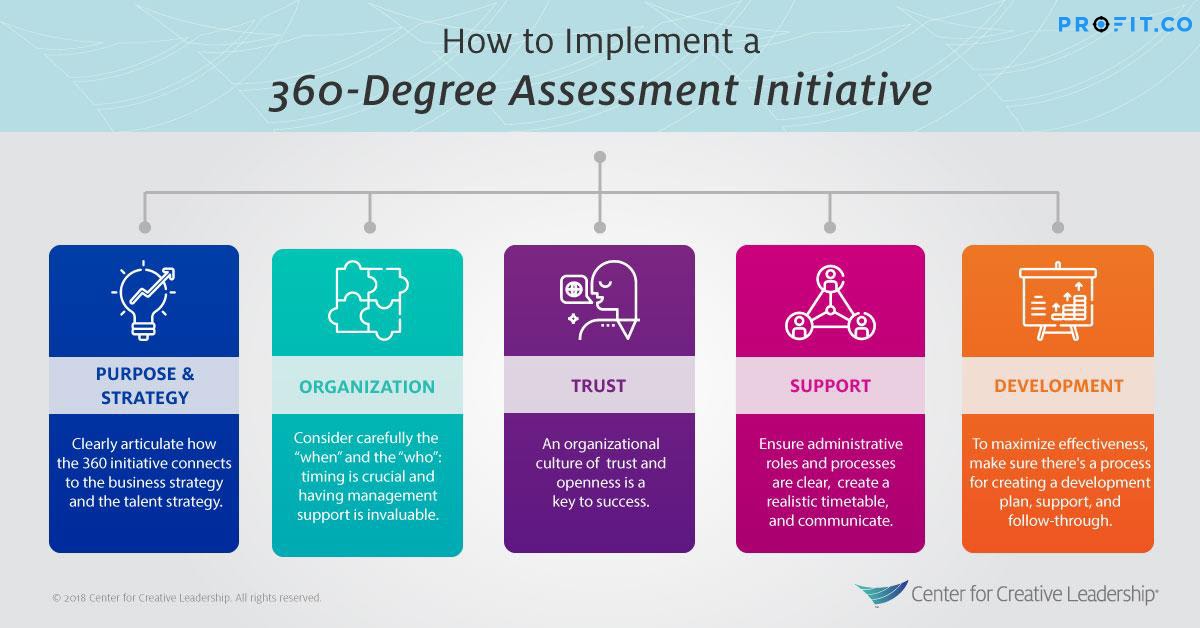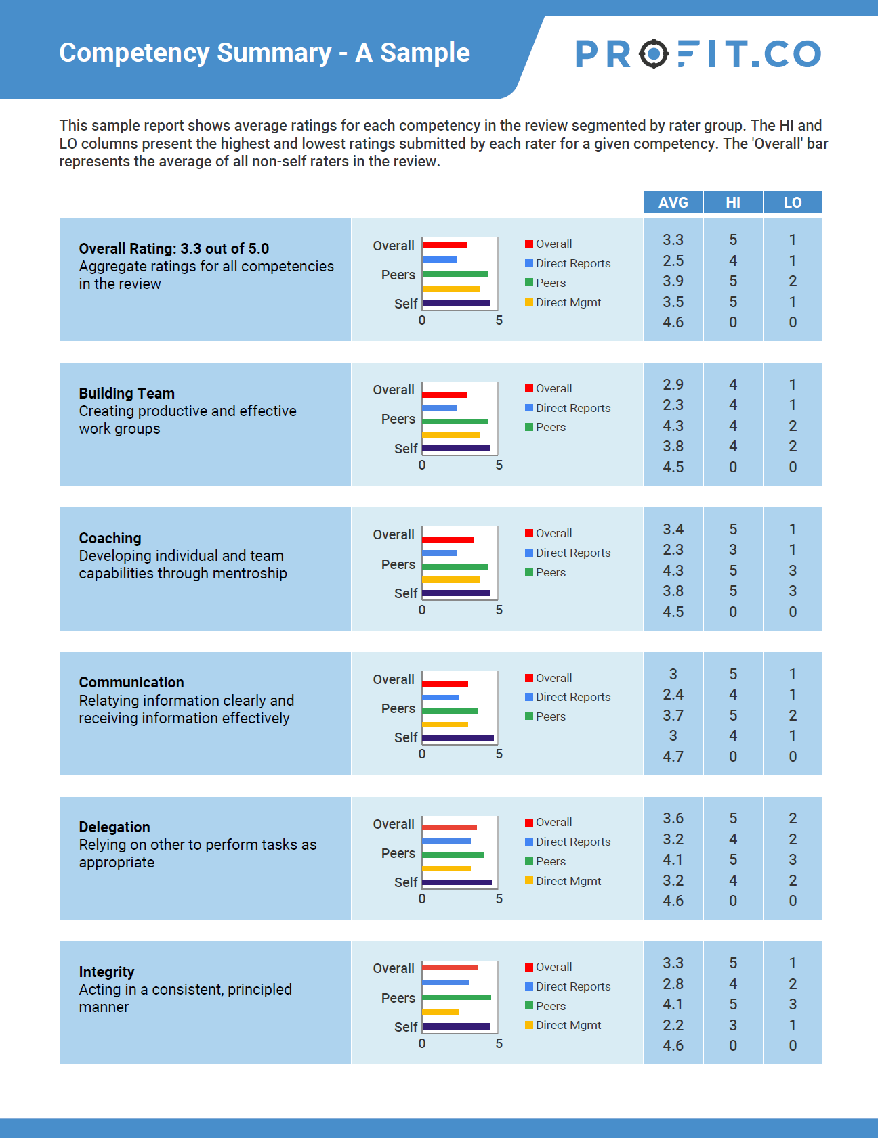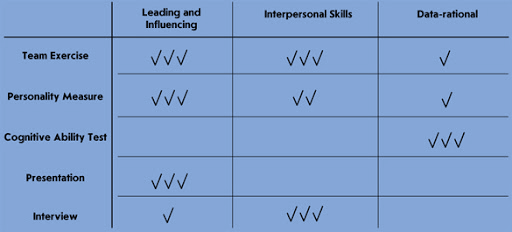Example of a 360 Degree Appraisal method summary form (Download a sample):
Performance appraisals provide important and useful information in assessing an employee’s performance, skills and knowledge. Every organization is different, its work culture, people, management, etc. Therefore, the most appropriate method of performance appraisal will depend on the nature of your organization, and on the variety of roles within your organization. The right kind of appraisal method for your organization makes all the difference when it comes to improving employee productivity. You can read more about how industry icons transformed their employee performance and increased productivity here.
Let’s take a look at 3 types of performance appraisal methods that help increase productivity:
360-degree appraisals
The 360-degree appraisal method is considered one of the best approaches. This method attempts to look at the employee as a whole person and not just through the eyes of the manager. It gathers feedback from an employee’s peers, direct reports and from people who have contact with the employee and therefore, as the name suggests, it gives a well-rounded, 360-degree feedback of the employee. Including reviews from co-workers and others who have contact with the employee in the performance review process helps authenticate the employee’s report and potentially help cover more ground during the review process, keeping biases at bay. This is done in a very formal and structured manner.
While it gives the manager a good insight into an employee’s attitude and behavior, the employee also benefits from it as the feedback helps him/her with self-improvement. Not only does it give a manager a precise understanding of an employee’s attitude and behaviour, but it can also benefit the individual by helping with self-improvement.

Source: Center for Creative Leadership
Key features of the 360-degree appraisal method that affects productivity:
- It increases the individual’s awareness of how they perform and the impact it has on other stakeholders.
- Serves as a key to initiate coaching, counselling, and career development activities.
- Encourages employees to invest in self-development and embrace change management.
Example of a 360 Degree Appraisal method summary form (Download a sample):

source: www.echospan.com
Management By Objectives
The Management By Objectives appraisal system has the employee and manager both jointly establishing objectives to be achieved by a certain time. Once an objective is agreed, the employee is expected to identify the skills needed to achieve the objective. They are expected to track and audit their own development and progress and not rely on others to audit their skills, strengths and weaknesses. This helps assess the employee’s capabilities for himself/ herself which helps improve his/her ability to perform well.
The idea behind this process is to identify an employee’s main objectives, which is later graded with group input. This helps all company contributors see their accomplishments in connection to the company’s top priorities. The Management By Objectives method helps define SMART Goals (i.e. goals that are Specific, Measurable, Actionable, Relevant and Time-bound), which makes this method a very results-oriented approach.
It’s a democratic style of system where every employee is encouraged to participate in achieving the organization’s goals, while benefiting from them tremendously personally.
Key features of the Management by Objective method and how it affects productivity:
- It’s a modern approach to performance management as the company, together with the employee sets realistic and objective goals, and looks at how well they were accomplished.
- With this method highlighting the area/s in which the employees need further training, leading to career development, they get a lot of encouragement from top level managers.
- It brings to the fore the employee’s contributions which tie in with the company’s objectives, thereby making the employee more invested in his role and in the company.
Examples of Management By Objectives examples (for the Human Resources Department)
- Maintain employee satisfaction index of 85%
- Keep quarterly retention rate at 97%
- Increase employee engagement to 85%
- Maintain compensation at 10% above industry average
- Meet with sales department to define sales hiring requirements
- Hold a minimum of three interviews for new hires
- Increase rate of meeting new hire deadline to 80%
- Get 15% of hires from employee references
- Hire a training agency for the sales department
- Implement 1-on-1 automation system in Q2
- Increase departmental ROI by 5%
- Hold two company-wide events
- Implement a leadership training program
- Give at least 1/3 of all managerial positions to internal applicants
(SOURCE: https://www.workfront.com/strategic-planning/goals/mbo)
Assessment Center Method
The Assessment Center Method is a process where candidates are assessed to determine if they fit the bill for specific roles. It gives employees a very good idea about how others observe them and the impact it has on their performance.
This type of performance assessment is used in many different types of organizations. It’s used for recruiting and in determining training and developmental needs in an organization. It assesses the existing performance of an individual, and also predicts future job performance.
An assessment center process typically involves common job simulations such as:
- In-basket exercises
- Group discussions
- Simulations of interviews with “subordinates” or “clients”
- Fact-finding exercises
- Analysis/decision-making problems
- Oral presentation exercises
- Written communication exercises
These methods help evaluate the candidate’s capabilities and skills that are required when they take on a certain role and responsibilities. The nature of these assignments and exercises would be such that it elicits a behavior that would be expected of the candidate/s and relevant to the position or job for which they are being considered. The evaluators are trained to evaluate employees as they perform the assignments and exercises on job related parameters. Some of the major skills that are judged during the assessment center process are interpersonal skills, intellectual abilities, planning and organizing capabilities, motivation, and career orientation.
Simulations are designed to bring out behavior relevant to the most important aspects of the position or level for which the assessees are being considered.
Key features of the Assessment Center Method and how it affects productivity:
- Multiple job simulations help assess a candidate’s competencies that are required for a certain job
- Assesses behavior observed during simulations to predict future behavior towards target job
- A systematic data integration session involving several assessors who have observed participants independently in the simulations
Example of Assessment Center Method:
Your manager wants a presentation to be done within an hour. Your client wants you to work on the changes on the campaign within the next hour because he has to present it internally to his team in 3 hours. The vendor needs to be paid in the next 30 minutes else he’s going to withdraw his offer. Your wife wants you to pick your daughter up from school early today. And in the middle of all this, you have requests and phone calls coming in.
Now with all this going on, and with so many tasks that overlap, it is up to you to prioritize and decide how to handle all these tasks. Whether to do yourself or delegate it to someone else.
Usually, not all of these simulations exercise can be completed in the given time-frame. The key is to not panic and have a nervous breakdown but to demonstrate to the company and assessors how you would cope with a difficult situation, and how focused you can be given a situation like that.
In the feedback discussion after the exercise, it is important for your assessors to understand why you took the steps you did, what was your motivation to prioritize certain tasks and why you delegated some and handled some on your own. There are no right or wrong answers. It’s all about justifying your decisions.
How an Assessment Center Method evaluation form would look like:

Figure 2 Assessment Centre Appraisal method form
In Summary
The right performance appraisal method for your organization, and for the different kinds of roles within the organization, can better employee performance. A good employee performance review method can make the whole experience rewarding and help to increase productivity of the appraisee.
Example of a 360 Degree Appraisal method summary form (Download a sample):
